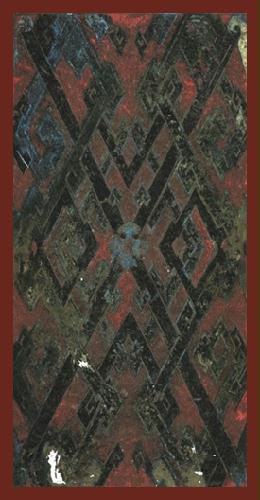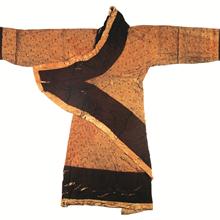Dimensions: Length: 81.5cm; width: 42cm
Origin: Unearthed from Han Tomb No.1 at Mawangdui, Changsha City, Hunan Province,1972
Quite a lot of thin silk has been unearthed from Tomb 1, among which the most eye-catching is the thin silk with feathers used to decorate the outside surface of the innermost coffin. This is the first time when such fabric was discovered in China.
When it was buried, the innermost coffin decorated with brocade was tied with two bands of silk. After that, the lid and the four walls of the coffin were pasted with a layer of thin silk with applied feather. Finally a strip of full-piled embroidery 12 centimeters wide was added around the thin silk with applied feather. This is the first time when such burial practice with silk fabrics pasted for decoration was found in China.
The process of making the silk with feather is very complicated. First, the silk has to be smoothed and starched before lozenge patterns are drawn on it in black and red colors as the draft. Then orange and darkish blue feathers are pasted in a forward direction while a thin silk strip of 2.8 centimeters wide is pasted between the feathers to form lozenges.
The persimmon stem patterns in the center were added separately by using small pieces of thin silk pasted with feathers. The fringes around the patterns are decorated with bands 0.9cm wide. This makes the final product clear-layered and brightly-colored, with a strong decorative effect. When used to decorate the innermost coffin, it symbolized that the deceased had put on a dress made of feather. Official History of Han Dynasty: Book of Sacrificial Ceremonies records: “Wear feather clothes and stand on cogon.” Shi Gu explains: “Feather clothes refers to clothes made of bird feathers, to symbolize immortals flying in the sky.”
The people of the Han Dynasty used such the silk with feathers to decorate the innermost coffin possibly to denote it as feather clothes and to wish the deceased to fly to the sky and become an immortal.





